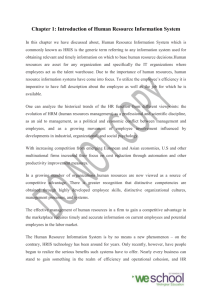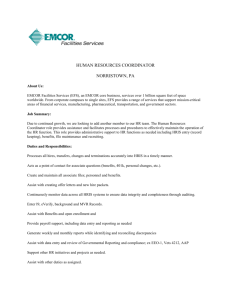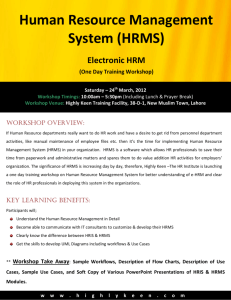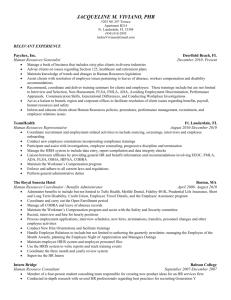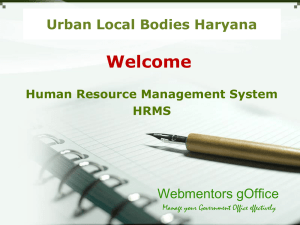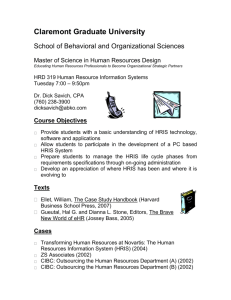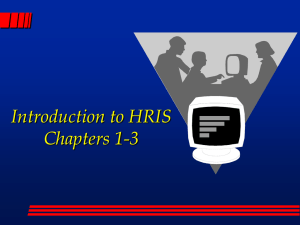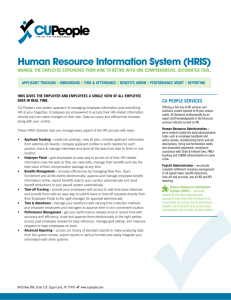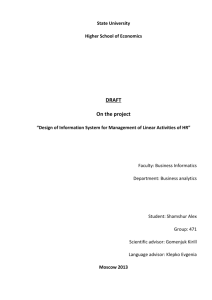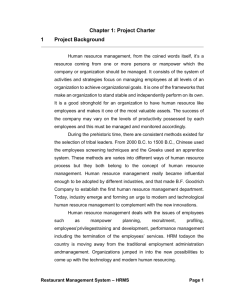Course Description
advertisement
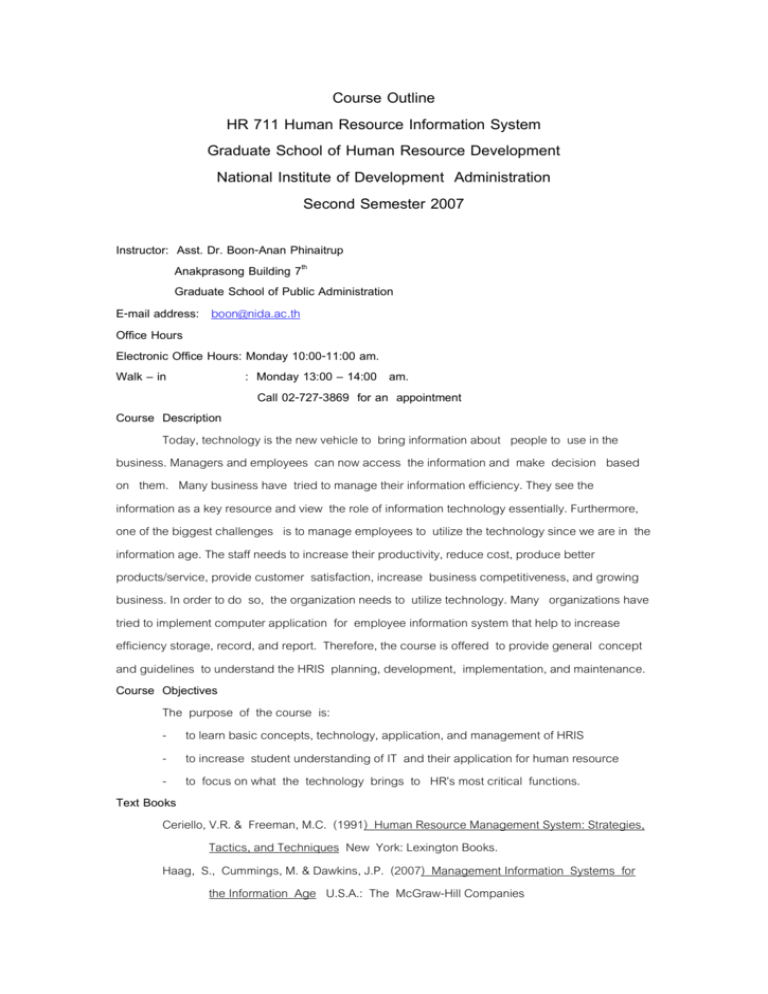
Course Outline HR 711 Human Resource Information System Graduate School of Human Resource Development National Institute of Development Administration Second Semester 2007 Instructor: Asst. Dr. Boon-Anan Phinaitrup Anakprasong Building 7th Graduate School of Public Administration E-mail address: boon@nida.ac.th Office Hours Electronic Office Hours: Monday 10:00-11:00 am. Walk – in : Monday 13:00 – 14:00 am. Call 02-727-3869 for an appointment Course Description Today, technology is the new vehicle to bring information about people to use in the business. Managers and employees can now access the information and make decision based on them. Many business have tried to manage their information efficiency. They see the information as a key resource and view the role of information technology essentially. Furthermore, one of the biggest challenges is to manage employees to utilize the technology since we are in the information age. The staff needs to increase their productivity, reduce cost, produce better products/service, provide customer satisfaction, increase business competitiveness, and growing business. In order to do so, the organization needs to utilize technology. Many organizations have tried to implement computer application for employee information system that help to increase efficiency storage, record, and report. Therefore, the course is offered to provide general concept and guidelines to understand the HRIS planning, development, implementation, and maintenance. Course Objectives The purpose of the course is: - to learn basic concepts, technology, application, and management of HRIS - to increase student understanding of IT and their application for human resource - to focus on what the technology brings to HR’s most critical functions. Text Books Ceriello, V.R. & Freeman, M.C. (1991) Human Resource Management System: Strategies, Tactics, and Techniques New York: Lexington Books. Haag, S., Cummings, M. & Dawkins, J.P. (2007) Management Information Systems for the Information Age U.S.A.: The McGraw-Hill Companies พิชิต พิทกั ษ์ เทพสมบัติ และ บุญอนันต์ พินยั ทรัพย์ (2550) ข้ อมูล ข่าวสาร และ ระบบสารสนเทศงาน ทรัพยากรมนุษย์ กรุงเทพฯ : สานักพิมพ์เสมาธรรม Method of Instruction 1. Lecture and discussion 2. Group activity 3. Case study 4. Computer Laboratory Room 5. Presentation Learning Links http://www.albany.edu/hris http://www-adm.pdx.edu/user/fadm/hris.htm http://www.peoplesoft.com http://www.ethics.ubc.ca/resources/computer/ http://www.acm.org/sigcpr/ http://www.ihrim.org/ http://www.chrt.com.au/hrismain.html. http://www.ihrim.org/resources/Publications/automating-the-workplace.html Minimum Computer Capacity The minimum technological elements are: - Windows 98 or better - 33.6 kbps or better modem - access to the Internet - Netscape 4.7 or Internet Explorer 5.0 or better - E-mail access Topic areas recommended for a research paper 1. Improving organizational performance by implementing HRIS 2. The impact of computers and IT on organizations and employees (i.e. organizational structure, manage compensation programs, performance appraisal , training programs, employee benefits, human resources cost planning) 3. Issues in HRD/HRM, theoretically or practically, in relation to HRIS 4. Trends in HR department to be structured and operate with HRIS 5. The effects of computers and IT on career management of HRIS employees 6. End-user computing issues 7. Computer/IT impact and applications in HRD/HRM (distant learning, health improvement, self-learning projects, etc.) Class Participation and Policies 1. Students should arrive class on time or earlier. 2. Class participation is required for the course. Students should voice his/her opinion in class, ask questions, prepare themselves for class Student Responsibility 1. Students as individual can expect to be treated with courtesy and respect. 2. Students as individual can expect to communicate freely and to be able to voice alternative points of view in rational debate. 3. Students as individual can expect to enjoy a study environment at NIDA. 4. Students as individual can expect to be provided with accurate, timely and helpful information regarding the course work. 5. Students as individual should conduct themselves in a professional manner in and outside the class. 6. Students as individual should maintain the highest standards of academic integrity in their work. Course Evaluation 1. Grading score A-, A 90-100 B, B+ 80-89 C+, B70-79 C-, C 60-69 D 50-59 F less than 50 2. Class participation will be a self-evaluation. It means each student will grade his/her self based on the following criteria: Grade Attendance Discussion in class 100 Full attendance Active participation in class discussion 90 1-2 absences Active participation in class discussion 80 Three absences Active participation in class discussion 70 Full attendance Moderate participation in class discussion 60 1-2 absences Moderate participation in class discussion 50 Three absences Moderate participation in class discussion 40 Full attendance Little or no participation in class discussion 30 1-2 absences Little or no participation in class discussion 20 Three absences Little or no participation in class discussion 0 More than three absences Library Resources The library at NIDA is an integral part of the graduate and research programs of the university. Library resource include books, journal subscriptions and audiovisual materials. The library is also a primary access point to electronic information resources. The library offers instruction sessions for classes as well as detailed research assistance to students. The library offers graduate students electronic databases and Internet resources many of which are also available from home, office or computer lab. These databases provide access to a variety of materials including books, journal, and news paper. This will enable students to complete their learning exercises, assignments, homework, and case study. The working day for the library is Monday-Friday at 8:00-7;30 pm and weekend and holidays at 10:00 am – 6:00pm. Weekly assignment reading Haag, S., Cummings, M. & Dawkins, JP. (200ึ7) Management Information Systems for the Information Age USA: The McGraw – Hill Companies Week 1 Week 2 Week 3 Week 4 Week 5 Chapter 1 Chapter 2 Chapter 3 Chapter 4 Chapter 5 Chapter 6 Chapter 7 Chapter 8 Chapter 9 Chapter 10 Chapter 11 The Information age in which you live Information Technology Systems Strategic and competitive opportunities Databases and Data Warehouse Decision support and artificial intelligence Networks Emerging Technologies Planning for IT systems Developing IT systems Managing IT systems Preparing for the future Ceriello, V. & Freeman, C. (1991) Human Resource Management Systems New York: VRC Consulting Group, Inc. พิชิต พิทกั ษ์ เทพสมบัติ และ บุญอนันต์ พินยั ทรัพย์ (2550) ข้ อมูล ข่าวสาร และ ระบบสารสนเทศงาน ทรัพยากรมนุษย์ กรุงเทพฯ : สานักพิมพ์เสมาธรรม Week 6 Part I HRMS Planning Chapter 1 Human resources and HRMS Chapter 2 Planning and HRMS Week 7 Chapter 3 Chapter 4 Week 8 Part II Chapter 6 Chapter 7 Week 9 Chapter 8 Chapter 9 Week 10 Chapter 10 Chapter 11 Week 11 Part III Chapter 12 Chapter 13 Week 12 Chapter 14 Chapter 15 Week 13 Chapter 16 Chapter 17 Week 14 Chapter 18 Chapter 19 Week 15 Chapter 20 Chapter 21 Week 16 Part IV Chapter 22 Recommend readings Designing and HRMS Software for HRMS HRMS Implementations HRMS Vendors Use of Consultants in HRMS Contracts and warranties for HRMS HRMS Implementation Maintaining and enhancing HRMS Managing HRMS HRMS applications Applicant & employment management EEO and affirmative action Compensation Benefits Employee and industrial relations Training and development HR planning Occupational health and safety Payroll Other HRMS applications Trends & Resources Emerging Trends and the future of HRMS Aiken P.G.B. (1997) “Data reengineering fits the bill” Information week May. (632) 8A – 12A. Anonymous (1992) “Computers & Accounting : Hardward/software Reviews” Management Accounting. 74 (4) 22 - 25. “ (1997) “Case Study : No need for a $12 million investment in a new financial management system” Directors & Boards. 21 (3) 39 – 42. “ (1999) “Legal industry widens the SPECTRUM” Strategic Finance. 80 (11) 86. “ (2001) “What’s new” HR Magazine. 46 91) 143 – 146). Ashbaugh.S., Miranda.R (2002) “Technology for human resource management : Seven questions and answers” Public Personnel Management. 3 (1) 7 – 20. Berry. W.E. (1999) “Developing business objectives for HRIS” Human Resources Professional. 7 (6) 22 – 25. Broadie, B. (1996) “Use technology to untangle wage attachments” HR Magazine. 41 (4) 57 – 60. Eddy.E.R.,S., Dianna. L.Stone-Romero.E (1999) “The effects of information management policies on reactions to human resource information systems : An integration of privacy and procedural justic3e perspectives” Personnel psychology. 52 (2) 335 – 358. Giguere.M.D (1997) “Automation electronic records management in a transactional environment ; The Philadelphia story” American Society for Information Science, Bulletin (23 (5) 17 – 19). Greer.C.R, Youngblood, .S.A; Gray D.A.(1999) “human resource management outsourcing : The make or buy decision” Academy of Management Executive; 13 (3) 85 – 96. Groe. G.M., Pyle. W.J.J.J. (1996) “Information technology and HR” Human Resource Planning 19 (1) 56 – 61. Hubbard.J.C, Forcht. K.A. (1998) “Human resource information systems : An overview of current ethical and legal issues” Journal of Business Ethics. 17 (12) 1319 – 1323. Huth.S.A (1997) “Slow and fast. Deliberate and evolutionary : Many are the ways to move to outsourcing” Employee Benefit Plan Review. 51 (8) 32 – 36. Kovach, K.A, Cathgart.E.J. (1999) “Human resource information systems (HRIS) Providing business with rapid data access, information exchange and strategic advantage” Public Personnel Management. 28 (2) 275 – 282. Krumwiede.K.R, Roth>H.P (1997) “Implementing information technology innovations ; The activity-based costing example. SAM Advanced Management Journal. 62 (4) 143 – 156. Kuzmits. F.E. (1998) “Communication benefits ; A double-click away” Compensation & Benefits Review.30 (5) 48 – 51. Lindahi.R.V (1996) “Automation breaks the language barrier” HR Magazine. 41 (3) 79 – 83. Martinsons M.G. (1995) “Assimilating knowledge-based systems : The roads to success” Human Relations. 16 (8) 22 – 37. Meyer.G. (1996) “Abra HR for Windows a product of experience” HR Magazine. 41 (5) 122 – 126. Meyer.G (1996) “HR Task Counselor structures, streamlines and safeguards activities” HR Magazine. 41 (1) 40 – 46. Morgan.C.S (1995) “Administrative outsourcing ; Unanticipated opportunities for process Improvement”. Benefits Quarterly. 11 (3) 34 – 40. Munn, R.W. (1996) “Human Resource Manager offers efficient control of HR, payroll data” Human Resource Magazine. 41 (10) 40 – 44. Roberts.K.K. E.E; Ozeki. C. (1998) “Managing the global workforce : Challenges and strategies” Academy of Management Executive. 12(4) 93 – 106. Siegle.G.B (2000) “Outsourcing personnel functions” public personnel Management. (2) 225 – 236. Spoolman.S (1998) “Human resource management” Credit Union Magazine. 64 (3) 56 – 61. Targowski, A..S.; Desphande, S.P. (20001) “The utility and selection of an HRIS,” Advances in Competitiveness Research, 9(1), 42-56 “ (2001) “the utility and selection of an HRIS.” Advances in Competitiveness Research, 9 (1), 42 – 56. Townsend. A.M, Hendrickson, .A.R (1996) “Recasting HRIS as an information resource” HR Magazine. 41 (2) 91 – 64. Wijnhoven F. (1999) “Development scenarios for organizational memory information systems” Journal of Management Information Systems : JMIS. 16 (1) 121 – 146.
